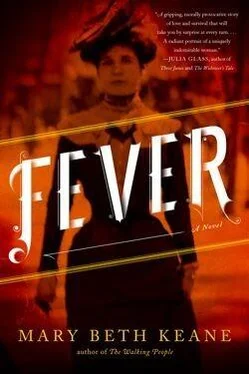“A few weeks,” Dr. Soper said. Mary told herself that she could put up with anything for a few weeks. She’d let them test her and when they got whatever it was they needed from her, the ordeal would be over, and she’d never have to see Soper again.
• • •
From the first hour of her arrival, North Brother Island seemed to Mary too flimsy for the roiling East River. It was as if a jagged corner of Manhattan had broken off and floated away before getting caught in the prehistoric rock that lurked just below the surface of the water. North Brother was a little skip of land, an oversized raft made of dirt and grass where the dying went to wait their turn. It was located just above Hell Gate, that point in the East River where half a dozen minor streams met head-on before rushing out to sea, and only a fool would dip her toe in the water there. The entirety of North Brother would barely be big enough for a respectable estate if it were anywhere but New York, but in New York, or at least in Manhattan, where even the very rich live within arm’s length of their neighbors, it was a rarity: a stretch of space that was quiet, and private, and where everyone there was meant to be there, adult men and women whose names appeared on the roster of approved persons the ferryman kept under the bench seat of his small vessel, protected from the spray.
There were no automobiles on North Brother, only a single horse, and that one old and mangy, retired from pulling a sanitation cart and donated to science. During the day, there were always a few bicycles leaning against the western gable of the hospital, the side closest to the ferry that carried the nurses and doctors back and forth from 138th Street in the Bronx, but no one ever used those bicycles to pedal around the island, and seeing them there, leaning haphazardly against the redbrick wall or lying on their sides on the grass, Mary needed no further proof that she’d been removed from the city. If she were in the city, in the real city, and not this in-between place, those bicycles would be gone inside an hour, liberated from their spots and cycled away by Lower East Side teenagers. There were few urban sounds on North Brother. No store shutters creaking open in the morning, clanging closed at night. No bells, no rumble of the El overhead, no peddlers hawking their wares, no children hopping balls, no old women shouting from upper-story windows. In their place were the sounds of tree frogs, birds, the gardener’s clippers slicing the hedges into neat squares, and everywhere, always, the sound of water lapping the shore. Everything, everyone, stayed put, at least until evening came, when the doctors hustled out to the pier to make the awkward step down into the ferry, and the night shift leaned into the slight incline of the walking path and through the hospital’s wide front door. The evening croak of a heron on the island’s eastern shore sounded to Mary like a taunt, and chilled her.
Sixteen buildings anchored North Brother, ranging in size from the main building of Riverside Hospital to the gardener’s toolshed. There was also the morgue, the chapel, the physical plant, the coal house, the doctors’ cottages, the nurses’ residences, the X-ray building, the greenhouse, and so on. The circumference of the entire island could be walked in less than three-quarters of an hour, and from any point on North Brother, unless there was a building or a tree blocking the view, one could look back and see upper Manhattan, and north of that, the invisible seam where Manhattan met the Bronx. When it rained, the current that charged over the pebbles and jagged stones of shore reminded Mary of a pack of galloping horses steaming toward the sea.
• • •
There were no Typhoid patients at Riverside on the day she arrived, so they assigned her a bed in the main Tuberculosis ward. A nurse provided her with paper and envelopes, a pen with a reservoir of ink. She wrote to Alfred what, by then, surely, he already knew, but unlike the letter she’d drafted in her mind when she was still at Willard Parker, the first letter from North Brother was matter-of-fact. No patient at Riverside Hospital was permitted to have visitors, so she counseled patience, told him it might help to pretend she’d gotten a situation too far away for her to visit — Maine, perhaps, or Massachusetts — and before he knew it she’d be home. She was angry, but had learned that anger wouldn’t get her far. “So I may not see you until Memorial Day,” she wrote. Worst-case scenario, she thought. Two whole months should be plenty of time. He’d had a difficult stretch over the winter, not working, spending far too much time at Nation’s Pub, but she decided not to mention any of that. “Remember the rent if you haven’t already.”
After listening to the hollow coughs from her fellow patients for a few days, Mary learned to predict the end: when a rattle in the chest sounded like a penny thrown into a very deep well that had gone dry. She observed that the consumptives looked like relatives: the same pall, the same dark rings under the eyes. They would stare at Mary and wonder what she was doing there. At night, she slept with the sheet over her face in case she might breathe in their disease, but after a week she stopped worrying. During the day, she couldn’t stop herself from flaunting her health, walking back and forth by the windows, asking the nurses if she could be of assistance. On sunny afternoons she took a book from the hospital library and read in the courtyard. On less temperate days she jotted down ideas for recipes so as not to lose her sense of purpose. She made sure to get outside every day, even if it was just for a few minutes, and when she got back to her cot and nodded to her neighbors, she felt the pink glow in her cheeks, the rise and fall of her chest, the power in her lungs. The confusion on their faces confirmed what she already knew: a mistake. A terrible error had been made, but would soon be corrected.
She submitted to their tests without protest and hoped that the sooner they collected all the information they needed, the faster they would let her go. She had not seen Dr. Soper since the first day she arrived on North Brother, and when she asked about it, Dr. Albertson told her that she likely wouldn’t be seeing much of Dr. Soper anymore. He might check in on her now and again, and of course her test results would be shared with him, but his part in her case was likely over. This tiny piece of good news lifted her spirits for a day.
The doctors on North Brother seemed even more greedy than those at Willard Parker to look at her body. They wanted her hands, her belly, her breasts, her hips; they wanted every wet thing that came out of her, top to bottom — but when they came to her face their eyes flicked away. Some of her interrogators weren’t doctors who had patients but different types of medical men, like Soper, who called himself an engineer but seemed to know diseases. Some of them only studied things and took notes. The questions had changed since Willard Parker. There, they wanted to know about every fever she’d ever had. Had she ever had a rash on her bosom? Now they demanded to know when she knew. You’re an intelligent woman, they said. Several of your employers said you read novels when you had time off. You must have known. How can you ask us to believe you didn’t know?
Mary tried to think of images that would block out the questions — any memory at all that would take her away from North Brother. But more often than not, thinking of Alfred and her friends made her less patient with their questions, more frantic to get home. She paced. She counted to one hundred, and when she was finished, she counted again. She closed her eyes, held her hands to her ears, and still, each question was a dripping tap, a loose shingle in the wind, a fly buzzing by her ear that she could never slap away.
Читать дальше












